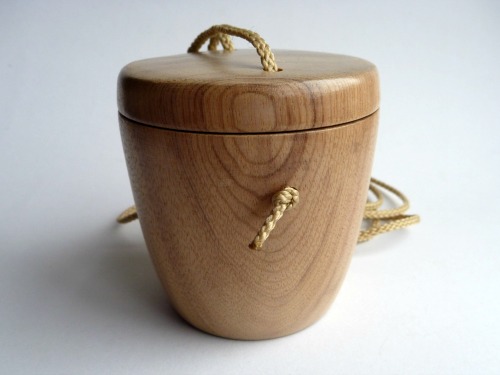Ultralight Worm Fishing
Trip Report 7-24-2016
Ultralight worm fishing for trout in streams is extremely effective!
So far I have written a number of essays that touch on the Japanese "Zero" fishing approach. Initially, I had thought it was "zero tension," based on the concept that fish would spit out even natural bait if they felt tension on the line. More accurately, Zero Fishing tries to come as close as possible to adding nothing (or "zero") to the natural bait.
A "Zero" rod has a very soft tip so the fish does not feel tension when taking the bait. The hook is a relatively small fine wire hook. The tippet is as light as the rod can handle, which for some rods is thinner than Varivas 10X, which is .064mm (.0025") and 1.1# test. The split shot is only as large as absolutely necessary to get the bait to the right depth. It is an entire system (hook, line and sinker - and rod) all working in concert to allow the most natural drift and to not alert the fish even after it has taken the bait.
On my July 24 trip, I proved to myself that fish will indeed spit out natural bait if they feel tension on the line. I was fishing a small (15 CFS) stream with a Suntech FMX Keiru extra stiff 5.3m rod and a very short line, essentially dipping a worm into all the eddies and seams that looked like they might hold a trout.
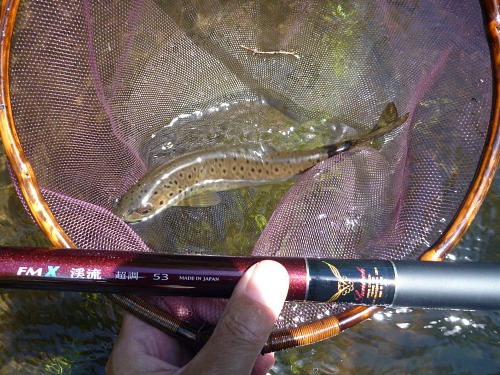
The trout were small, wild and numerous. I got lots of hits. I should mention they were also very, very quick. Out of lots of hits, I caught exactly one fish - and even for that one, a moment's inattention allowed some slack in the line (so when it took it felt no tension). When I noticed the slack and tightened the line there was a fish on the other end! For all the other fish, I felt a quick tap and then nothing. The fish reacted much faster than I did.
It was a fairly frustrating morning, so in the afternoon I tried the
exact opposite approach. Instead of a long stiff rod and a fairly short
line, split shot and yarn markers, I switched to a light flexible rod, a size 2.5 level fluorocarbon tenkara line about the length of the
rod, 3' of 8X tippet and no split shot. I stumbled on "ultralight worm fishing." [What I really stumbled on was "The Upstream Worm." I just didn't know it at the time.]
Ultralight Worm Fishing
The stream was shallow enough that I thought I wouldn't need weight to get the bait deep enough. I was sure the tenkara line would allow me to make the cast, after all, it casts flies without any added weight. The main question was whether the casting action would tear the worm off the hook. (Without question, one of the big advantages of fly fishing is that fur and feathers stay on a hook much better than worms and salmon eggs!)
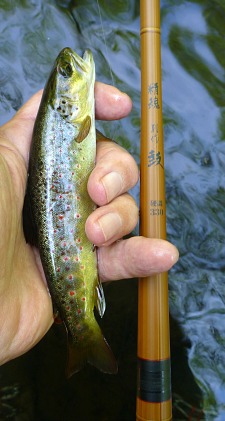
I started with my softest rod, a Nissin Seikon Bessaku Tsuzumi 330, which measures all of 6 pennies. The rod is so soft and the casting motion so slow and gradual that it did not tear the worm off the hook. The weight of the line, plus the weight of the worm itself made casts easy and accurate.
Basically, I waded up the middle of the stream (too many streamside trees and bushes to do anything else) casting upstream into every likely looking spot. As the worm drifted down towards me, I lifted the rod tip to keep as much of the line as possible off the water. To say the method was successful would be an understatement! I caught lots and lots of fish. This ultralight worm fishing had promise!
One of the things I realized was that the slight line sag you get with even a light line when tenkara fishing has the same effect as a very soft rod tip when keiryu fishing. You will see the take but the fish won't feel the tension. With a tenkara line, you can see the line pull forward or to the side, or hesitate, or just twitch, but the sag provides enough slack in the system that a fish can take the hook and not feel tension from the line. The ability of the line to register strikes turned out to be the key to ultralight worm fishing.
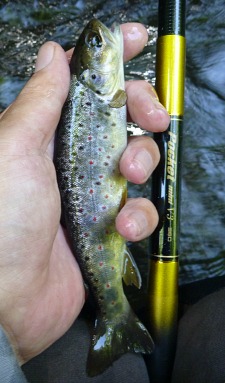
If you are fishing with an artificial fly, the fish will know
immediately that it isn't real. If you are fishing with a worm or salmon egg
or live nymph, though, using a small hook and no weight, you'll know it's there before it knows you're there.
My next question was whether the technique was limited to the softest of rods. Would it be possible to use a firmer rod and still not tear the worm off the hook when casting?
I switched from the extremely soft Tsuzumi to a Nissin Pocket Mini 360, a 17 penny rod that is much closer to the stiffness of a lot of tenkara rods. I switched the line from a size 2.5 fluorocarbon level line to a 3.6m Fujino White Tenkara line. The Pocket Mini cast the new line very nicely. By slowing my cast just a bit, concentrating on starting the forward cast slowly and accelerating smoothly, I still got great casts and did not rip the worm off the hook.
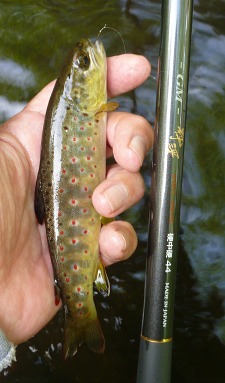
Where the stream opened up a bit I switched to a Suntech GM Suikei Keiryu Special 44 (since replaced by the TenkaraBum Traveler 44) and a size 3 level fluorocarbon line. The result was the same. Concentrating on making a smooth, jerk-free cast allowed me to cast a worm and not have it come off the hook.
For ultralight worm fishing
in small streams, using a seiryu or tenkara rod as opposed to a much
longer keiryu rod makes a lot of sense. The tenkara line provides the
weight needed for the cast, so a split shot is not necessary. Although I did not try it that day, in retrospect, a rod that would be ideal for this type of fishing is the Nissin Royal Stage Syunki seiryu rod. It is soft enough to cast the size 2.5 line nicely and smooth enough that it will not tear the worm off the hook. The Royal Stage Syunki has been discontinued, but the closest rod to it still in production is the Nissin Fine Mode Nagare, which indeed would do well for Ultralight Worm Fishing.
Even for larger streams, if the water is shallow enough that you don't need weight to get deep, a keiryu rod paired with a tenkara line will still give you the same natural drifts and allow you to cover more of the stream.
One thing gradually became obvious as the afternoon progressed. I wasn't getting snagged on the bottom. That is one of the biggest problems I have found while keiryu fishing in small streams. The depth is so variable that when keiryu fishing I kept getting the split shot stuck between rocks on the bottom. With ultralight worm fishing - no split shot - I got almost no snags. The unweighted worm seemed to go over and around rocks along with the current - which is just what a worm with no hook or line attached would do!
Ultralight worm fishing, using a rod light enough to cast a very light tenkara line and a worm with no additional weight is as close to a perfectly natural drift - as close to "zero" - as you are likely to get.
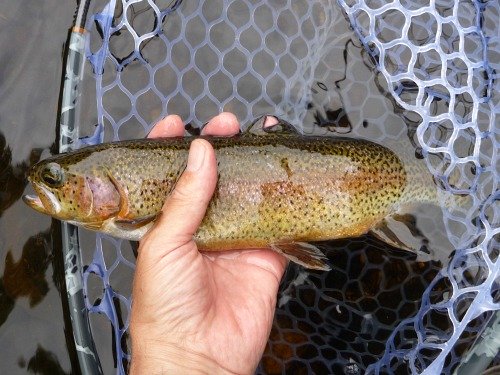
The following weekend, I tried ultralight worm fishing on a much larger stream. The water was deep enough that the unweighted worm did not get down to where I wanted it - or rather, to where the fish wanted it! I used a pair of #10 split shot, one about 6" and the other about 10" above the hook. They were sufficient to get the worm deep enough to interest the fish, yet they did not provide so much weight that they hung up on the bottom. Also, they were light enough that the casting motion still was smooth and soft - smoother even than casting a bead head nymph
For anyone who might be interested in keiryu fishing, but would like to try it before going out and buying a new rod, you can definitely try ultralight worm fishing with a tenkara rod on a small to medium stream. Use a softer rod, concentrate on a smooth cast, and use worms rather than salmon eggs. They stay on the hook much better and the trout are much less likely to swallow them before you set the hook. Since then, I have stopped fishing salmon eggs completely for that reason.
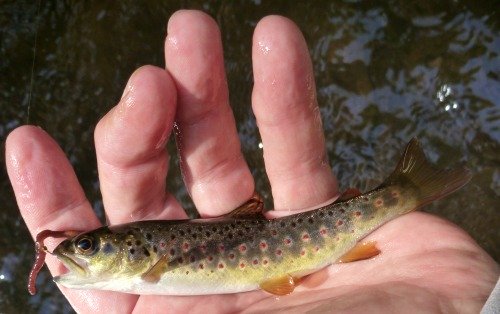
Do not use night crawlers. They are much too large and there is too great a chance that the fish will bite a part of the crawler that doesn't have a hook in it. You can't wait to make sure it has the hook because then the hook will be down its throat. Even the red worms or "trout worms" you can buy are likely to be too large and should be broken in half. I use red wigglers. The largest ones are less than 2" long and most are about an inch and a half. Meal worms or wax worms would be the right size, but they don't stay on the hook nearly as well.
Use light line, very light tippet, and small
light wire hooks. If the stream is shallow enough use no split shot at
all. If it is a bit deeper, one or two size 10 shot should do it. I have found the two #10 shot is sufficient for knee deep water. If the
current is knee deep and fast, though, it is not the right spot for ultralight
worm fishing. If you need more weight than a couple #10 shot, it really isn't "ultralight" any more and a standard keiryu rod and keiryu line would be better.
Back in the day, before the movie "A River Runs Through It" made worm fishermen look like fools, it was not uncommon to hear of people fishing a worm with a fly rod. However, the same advantage tenkara fishing has over fly fishing - the ability to keep the line off the water's surface - applies to ultralight worm fishing with a tenkara or seiryu rod rather than a fly rod. For short casts in small streams, the longer rod and lighter line are just more effective in producing a natural drift.
When WC Stewart wrote about fly fishing and worm fishing almost 160 years ago, he stated that a worm rod should be "at least four feet longer than that used for fly." What is popular in fishing rods changes over time, but the laws of physics don't. Long rods give you better drifts than short rods, and better drifts catch more fish.
I have since learned that this exact technique is known as "The Upstream Worm" or "Clear-Water Worm fishing" and Charles Cotton wrote about it in 1676.
TenkaraBum Home > Keiryu Trip Reports > Ultralight Worm Fishing
“The bitterness of poor quality remains long after the sweetness of low price is forgotten” - Benjamin Franklin
"Be sure in casting, that your fly fall first into the water, for if the line fall first, it scares or frightens the fish..." -
Col. Robert Venables 1662
As age slows my pace, I will become more like the heron.
We've all had situations where seriously chewed up flies kept catching fish after fish after fish. It is no sin to tie flies that come off the vise looking seriously chewed up.
Warning:
The hooks are sharp.
The coffee's hot.
The fish are slippery when wet.
Beware of the Dogma
What's in stock?
Suntech Tenkarakyo 40F Tenkara Rods
Old Geezer's Wide-Eyed Fly Box
Coming Soon
December
Kurenai II AR 30F
Kurenai II AR 33F
Kurenai II AR 39F
Nissin Oni Line size 3
Nissin Oni Line size 3.5
January
Furaibo TF39
Furaibo TF39TA
February
TenkaraBum 33
TenkaraBum 36
TenkaraBum 40
Latest Pages
Related Items
That ultralight worm fishing is a blast and you never leave without many fish caught. Thanks again.
Alton F, Tennessee
If you enjoy spin fishing or baitcasting please visit my sister site Finesse-Fishing.com.
Black Friday sale on now. 15% off on all Tenryu spinning and baitcasting rods.



